Historical buildings are not only beloved landmarks, but they also hold significant cultural and historical value. However, these buildings often lack modern safety features, making them vulnerable to fires. Fire suppression systems play a crucial role in protecting these structures, including the installation of hitzebeständige Abgasschläuche (heat-resistant exhaust hoses), which are key components of such systems.
One of the main challenges in historical buildings is their construction materials. These materials, such as wood, thatch, and plaster, are highly flammable and can quickly ignite. Moreover, due to their age, these buildings may have outdated electrical wiring systems, which increase the risk of electrical fires. This highlights the necessity of fire suppression systems in preserving these historical treasures.
Fire suppression systems offer an effective means of quickly detecting and suppressing fires before they have a chance to spread and cause significant damage. These systems include smoke detectors, fire alarms, sprinkler systems, and heat detectors. Among these, the role of hitzebeständige Abgasschläuche is often overlooked but is of utmost importance.
Hitzebeständige Abgasschläuche, which translates to heat-resistant exhaust hoses, serve as vital components of fire suppression systems in historical buildings. These robust hoses are capable of withstanding high temperatures and directing smoke, gases, and heat away from the fire site, preventing the further spread of flames and reducing the risk of structural damage.
The use of hitzebeständige Abgasschläuche in historical buildings offers several advantages. Firstly, their heat-resistant properties ensure that the hoses do not degrade or melt under high temperatures, allowing them to effectively contain and redirect smoke and hot gases. This helps preserve the integrity of historical structures, as corrosive gases and intense heat can cause severe damage to sensitive materials.
Secondly, these exhaust hoses facilitate the safe evacuation of occupants in case of a fire. By directing smoke and gases away from the building’s exit routes, the hoses provide clear pathways for people to escape, minimizing the risk of injuries or fatalities. Additionally, hitzebeständige Abgasschläuche help maintain visibility in the building’s interior, allowing firefighters and other emergency personnel to navigate safely and respond efficiently to the situation.
Lastly, incorporating hitzebeständige Abgasschläuche into fire suppression systems enhances the overall effectiveness of such systems. By efficiently removing smoke and gases, these hoses enable the sprinkler systems to function optimally, preventing the spread of fire and effectively extinguishing flames. This synergistic approach ensures that historical buildings remain adequately protected, reducing the risk of significant structural damage and potential loss of irreplaceable historical artifacts.
In conclusion, fire suppression systems are essential for the protection of historical buildings, and the inclusion of hitzebeständige Abgasschläuche adds a critical layer of safety. These exhaust hoses play a vital role in containing and redirecting smoke, gases, and heat away from the fire site, helping preserve the building’s integrity and facilitating safe evacuation. By investing in robust fire suppression systems, we can ensure the preservation of our cultural heritage and safeguard these historical treasures for future generations to cherish.
************
Want to get more details?
TAL Systemtechnik GmbH
https://www.tal-systemtechnik.de/
+49 7731 68405
Byk-Gulden-Straße 36, 78224 Singen
TAL Systemtechnik GmbH – Wir produzieren und liefern Ihnen konfektionierte Dämmstoffe nach Maß, Akustische Dämmung zur Schallisolierung, den TL flexibler Abgasschlauch hitzebeständig und diverse Schallschutzvorhänge für die Industrie.










